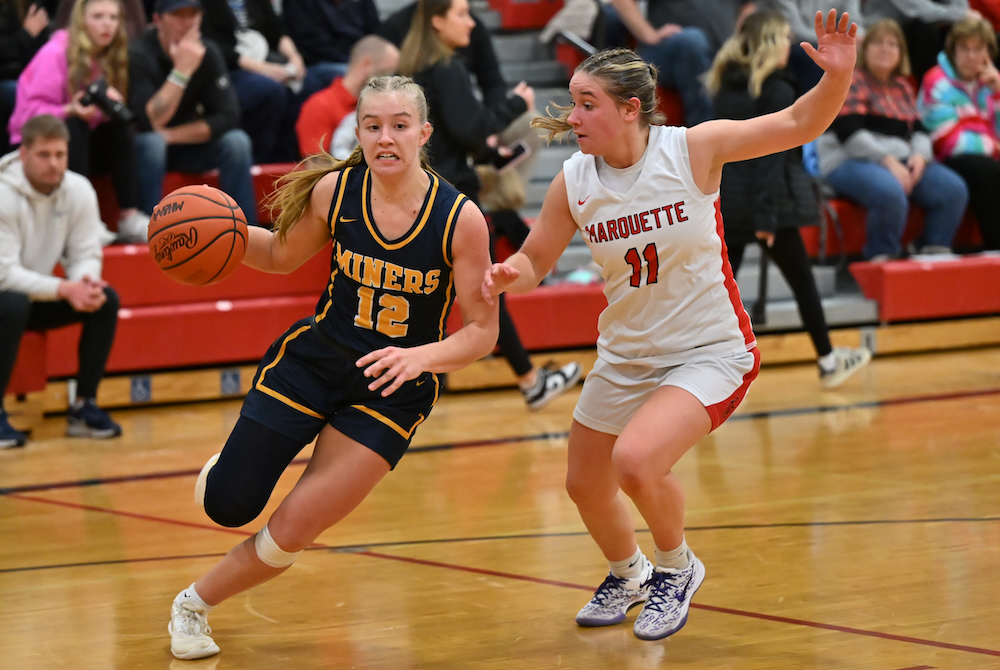
Classes Still Create Hoosier Hysteria
July 27, 2017
By Rob Kaminski
MHSAA benchmarks editor
This is the fourth part in a series on MHSAA tournament classification, past and present, that will be published over the next two weeks. This series originally ran in this spring's edition of MHSAA benchmarks.
Twenty years ago, Bloomington North High School won the Indiana High School Athletic Association boys basketball championship, defeating Delta 75-54 at the RCA Dome in Indianapolis.
The date, March 22, 1997, is at the same time revered and disdained by traditionalists in the state who saw it as the last schoolboy championship game the state would ever host.
That’s how devout the game of basketball, particularly interscholastic basketball, had become in the Hoosier state during the 87 years a state champion – one state champion, to be precise – was crowned.
Following that 1997 season, the IHSAA moved to a four-class system for its roundball tournaments, like so many of its state association counterparts had done years earlier.
It would be shocking to find more than a small percentage of current high school basketball players around the country unfamiliar with the iconic movie Hoosiers, even though the film is now more than 30 years old.
And, the storyline for that blockbuster unfolded more than 30 years prior to its release, when small-town, undermanned Milan High School defeated Muncie Central High School 32-30 in the 1954 IHSAA title game.
Perhaps it’s because of the David vs Goliath notion, or the fame of the movie that replaced Milan with the fictional Hickory and real-life star Bobby Plump with Hollywood hero Jimmy Chitwood, or the simple fact that Indiana had something other states didn’t.
Whatever the reason, plenty of opposition remains to this day to basketball classification in the state.
The fact is, the small rural schools were regularly being beaten handily by the much larger suburban and city schools as the tournament progressed each season.
Small schools also were closing at a rapid rate following the state’s School Reorganization Act in 1959, as students converged on larger, centralized county schools. From 1960 to 2000, the number of schools entering the tournament dropped from 694 to 381, and in 1997 a total of 382 schools and 4,584 athletes began competition at the Sectional level (the first level of the IHSAA Basketball Tournament).
It was at the entry level of the tournament where school administrators felt the pain of the new class system, but not necessarily for the same nostalgic reasons as the fans who either attended or boycotted the tournament.
At the Sectional round of the tournament, the IHSAA was culling just 2 percent of the revenue, with the participating schools splitting the balance. So, when Sectional attendance dropped by 14 percent in that first year of class basketball, many schools realized a financial loss. It was money they had grown to count on in prior years to help fund various aspects of the department.
Schools cumulatively received more than $900,000 from Sectional competition in 1998, but that total was down from more than $1 million in the last year of the single-class tournament.
Yet, the current format provides a great deal more opportunity and realistic chances at championship runs for schools of all enrollments.
To date, 60 additional teams have championship or runner-up trophies on display in school trophy cases around Indiana.
That was the mission in front of then-IHSAA commissioner Bob Gardner (now National Federation executive director) once the board made its decision: to give thousands more student-athletes the opportunity for once-in-a-lifetime experiences.
As any statistician knows, figures can be manipulated to tell any side of a story. Declining attendance in year one of class basketball is such a number.
The truth is tournament attendance had been on a steady downward spiral since its peak of just over 1.5 million in 1962. By the last single-class event in 1997, the total attendance was half that.
The challenge then and today, as it is for all state associations, is to find that delicate balance for those holding onto tradition, those holding onto trophies, and the number of trophies to hand out.
Editor’s Note: Stories from the Fort Wayne Journal Gazette in 1998 and from a 2007 issue of Indianapolis Monthly provided facts in this article.

Breslin Bound: 2025-26 Girls Report Week 1
By
Geoff Kimmerly
MHSAA.com senior editor
December 15, 2025
We’re one week into the 2025-26 girls basketball season, and several annual contenders wasted little time seeing how they match up against each other – at least to start this winter.
Of course, there’s a long way to go before all is said and done. But there were plenty of solid statements, with more opportunities to shake things up as we settle into holiday break this weekend.
“Breslin Bound” is powered by MI Student Aid and based on results and schedules posted for each school at MHSAA.com.
Week in Review
The countdown of last week’s five most intriguing results:
1. Howell 41, Detroit Edison 26 The Highlanders (3-0) closed an impressive first week by downing Edison (2-1) at the Best of Michigan Holiday Classic at Belleville.
2. Frankenmuth 48, Portland 46 These two have played a series of stunners over the last two seasons, as Portland (1-1) won last year’s regular-season meeting by one and Frankenmuth (2-0) avenged in a Division 2 Regional Final.
3. Bath 71, Fowler 41 The Bees (3-0) avenged last season losses by nine and 34 to the Eagles (0-2), the reigning Division 4 champions.
4. Wayne Memorial 55, Detroit Renaissance 33 Wayne (2-0) won this rematch of a Division 1 Regional Final from last season, also won by the Zebras, at the Best of Michigan Tournament at Detroit Mercy.
5. Jackson Lumen Christi 50, Michigan Center 28 The Titans (2-0) opened in a big way in a matchup of teams that both won 19 games last winter.
Watch List
With an eye toward March, here are two teams in each division making sparks:
DIVISION 1
Plymouth (3-0) After back-to-back six-win finishes earlier this decade, Plymouth improved to 14 victories two seasons ago and 15-8 last winter. The Wildcats could be ready to take another step after opening this season with a 30-point win over Flat Rock, a 17-pointer over Dearborn Heights Crestwood and a 19-point victory over Brownstown Woodhaven. They’ll have a chance to avenge last season’s first defeat, to Berkley, when they meet Friday.
Rochester Hills Stoney Creek (3-0) Last year’s solid 16-8 run started with a loss to Walled Lake Northern, but Stoney Creek got off to a better start this time with a 35-32 victory over Northern last week. The Cougars followed with 41-32 victories over both White Lake Lakeland and Rochester Adams, and they could get another good gauge on their early-season progress when they host Goodrich on Wednesday.
DIVISION 2
Ionia (2-0) The opening week gave the Bulldogs a spark, and they’ll have an even bigger opportunity this week. Ionia started with a 51-44 win over St. Johns – avenging a loss from a year ago – before defeating Lake Odessa Lakewood. But these next few days could be telling, as Ionia hosts Eaton Rapids on Tuesday after tying the Greyhounds for second in the Capital Area Activities Conference White last winter. On Friday, Ionia travels to face reigning champion Portland, which also ended the Bulldogs season in March.
Kalkaska (2-0) Last week was one of the most successful for the Blazers in some time as they opened with a 33-32 overtime victory over Mancelona, then edged Benzie Central 26-23. Kalkaska finished 3-19 last season – and had won a combined five games over the last four. The Blazers will play in this weekend’s Elk Rapids Invitational to finish up a memorable December.
DIVISION 3
Lawton (2-0) A 50-45 win over South Haven and 53-30 victory over Constantine got the Blue Devils moving in the right direction again as they look to build on last winter’s 15-6 finish and third place in the Southwestern Athletic Conference Valley. Next up is Kalamazoo Hackett Catholic Prep – which finished second in the Valley last season, defeating Lawton twice – before the Blue Devils close 2025 with Watervliet at the Bangor Holiday Shootout.
Tawas (3-0) Tawas has jumped from four, to eight, to 13 wins over the last three seasons, and could be in for an exciting run given its success during the first week. A 44-32 win over Houghton Lake avenged a 30-point loss from last season, a 36-32 victory over Au Gres-Sims avenged a 20-point defeat from February, and a 27-16 win over Alpena came after 20 and 25-point losses to the Wildcats last winter.
DIVISION 4
Auburn Hills Oakland Christian (3-0) The Lancers have won 14 or 15 games three times this decade, including in going 15-9 a year ago, and they are well on their way to approaching those totals again. Oakland Christian hung on for a 32-26 win over Bloomfield Hills Academy of the Sacred Heart, but defeated Pontiac and Brighton Charyl Stockwell Academy by much more comfortable margins.
Reading (3-0) The Rangers finished fifth in the Big 8 Conference last season, but then won a pair of close matchups to claim a District title and advanced all the way to the Regional Finals. They earned double-digit wins over Camden-Frontier, Colon and Litchfield to kick off this campaign last week, and Tuesday’s matchup with reigning Big 8 co-champion Bronson could tell a lot.
Can’t-Miss Contests
Be on the lookout for results of these games coming up:
Friday – Rockford (2-0) vs. Howell (3-0) at Cornerstone University – These two are in a high-powered Cornerstone Invitational bracket with DeWitt and Coldwater.
Friday – Concord (0-1) at Bronson (0-1) – This pair shared the Big 8 Conference title last season after splitting their regular-season series.
Saturday – Tecumseh (3-0) at Detroit Edison (2-1) – The 2023 Division 2 champion Pioneers – semifinalists last year – host the reigning title winner at their Pioneer Classic.
Dec. 29 – Pewamo-Westphalia (2-0) at Flint Powers Catholic (1-0) – P-W won last year’s matchup 53-50 on the way to finishing 25-1, while Powers went enjoyed an 18-6 run.
Jan. 3 – Tecumseh (3-0) at Grand Rapids West Catholic (2-1) – Tecumseh definitely isn’t taking it easy over break, with this a rematch of last winter’s Division 2 Final.
MHSAA.com's weekly “Breslin Bound” reports are powered by MI Student Aid, a division within the Department of Lifelong Education, Advancement, and Potential (MiLEAP). MI Student Aid encourages students to pursue postsecondary education by providing access to student financial resources and information. MI Student Aid administers the state’s scholarship and grant programs that help make college Accessible, Affordable and Attainable for you. Click to connect with MI Student Aid and find more information on Facebook and X @mistudentaid.
PHOTO Negaunee's Gretel Johnson drives to the net while being defended by Lexi Curran during the Miners' 43-26 win over Marquette on Dec. 9. (Photo by Cara Kamps.)


